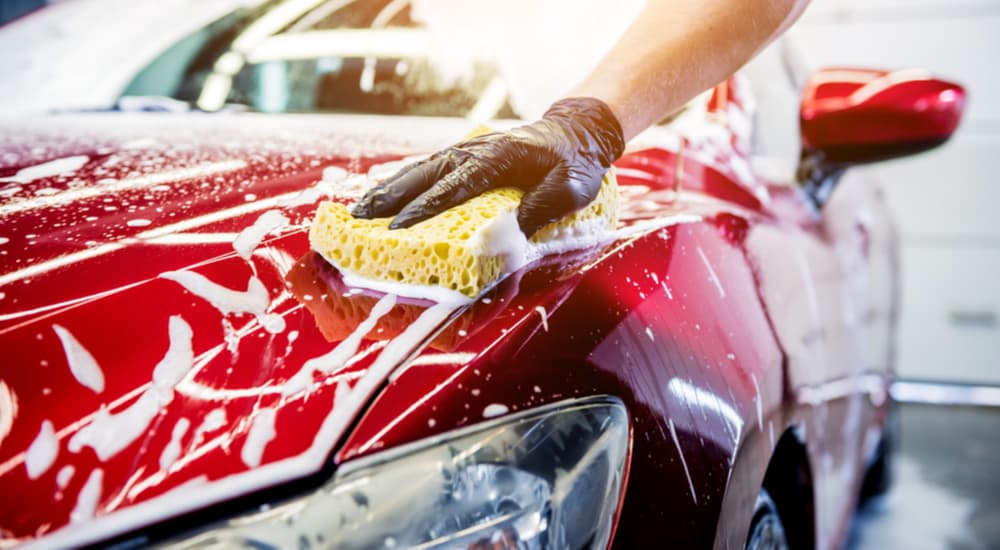Car selling can be nearly as, if not more, stressful than car buying. A lot of thought needs to go into the prep work before you sell your car. You need to be thinking of what you should repair before selling or what presale routine maintenance needs to happen. And that’s just to start. You’ll also need a handle on your vehicle’s value, the cleanliness of your title, and who you are aiming to sell to. Are you selling privately? Using a dealership? Or are you thinking of trading in?
These are all things you need to think of when you’re preparing to sell your car, but our focus today is going to be on the maintenance aspect. Why won’t anyone buy your car? Well, maybe it has something to do with the frame rust or the fact that there’s a mighty big dent in the back bumper. Big-ticket items like that need to be addressed, but we can’t forget the smaller ones. When was your last oil change? Have you ever gotten an oil change? Do the tires pass the penny test? If this seems overwhelming, take a deep breath. We’ll walk you through, step-by-step, what maintenance you need to do before selling your car.
Bodywork: What Damage Can We See?
No one is going to buy a car that has visible damage. No one. A small scratch that’s barely visible is innocuous – though we recommend you still touch it up. It’s the big stuff: dents, missing mirrors, missing bumpers. Any major cosmetics that you’ve been avoiding absolutely need to be fixed if you want to sell your car for maximum value. Reach out to your mechanic as a reference or search online for shops that specialize in bodywork. More often than not, your mechanic should be able to fix any visible damage, but it’s important to know where the bodywork specialists in your community are.
The Hidden Damage: Rust and Mechanical Failures
It’s just as important to repair the damage you can’t see. Check for rust, the killer of millions of autos. Make sure your car is on a smooth, level surface and that the parking brake is engaged while you do this. Lie flat on your back and, with a flashlight, do a brief scan of your car’s undercarriage. You should be able to tell just by looking whether or not you have a serious rust problem.
This is not insurance, but it helps you get a general idea. Again, your best line of defense is to take your car to the mechanic, lift it up, and have them walk you through what they see as potential problems. Your mechanic will be able to tell the difference between what is harmless surface rust and what is rusted to the point of danger. If harmful rust is present, make sure the damage is removed and replaced.
This applies to any mechanical failures as well. Broken exhaust pipes, engine constantly overheating, weird noises, check engine light that’s been on for gosh knows how long. Any minute inkling of a mechanical defect needs to be addressed ASAP. Not doing so could not only risk your sale but could risk the safety of your buyer and, potentially, your wallet.

Brakes, Lights, and Windows
One of the most expensive repairs that can ever befall your car is brake replacement. Good brakes are imperative not only for your safety but for the safety of others. Regardless of how you feel about your car’s braking ability, have them checked. If someone takes your car for a test drive and the brakes are spongy, or it takes the car several hundred feet to stop, the chances they’ll be buying are slim. So get your brakes checked. It’s worth it for the safety of all parties concerned.
Lights and tires are not something we tend to think much of until they need replacing, but it is a good idea to check them all before selling. To check to see if all your lights are in working order, engage the help of a friend, spouse, or whichever one of your children needs punishment, turn on your lights, do a brake check, and then directional check. As you do this, your employed help will walk around the car and see which, if any, of your lights are dysfunctional and in need of replacing.
When it comes to tires, any that are not immediately noticeable as having worn down treads must be subjected to the tried-and-true Penny Test. To do this, simply take a penny and, with Abe’s head facing down, stick it between the treads of all four of your tires. If the majority of Lincoln’s head is well hidden behind the tread, you’re in the clear. If all of Lincoln’s head is showing, your tires are worn down and need replacing.
Similarly, you are going to want to make sure all of the windows are in working order. Check that they can roll up and down and that there are no chips or obvious smudges. This includes your front windshield and rear window. These things may seem minor, but if they need to be fixed or replaced by a new owner, they can quickly bring the value of your car down.
Oil and Fluid Changes
Oil changes can be done in a few different ways. You could do it yourself if you’re mechanically inclined. Our recommendation, however, is to take it to your mechanic or visit an oil change service center like Valvoline or JiffyLube. When potential buyers are checking under the hood, they’ll either check the oil dipstick themselves or ask you when your most recent oil change was. In either situation, you should be prepared either with recently changed oil or a receipt from whoever changed it for you. The receipt should also include the upcoming mileage checkpoint for any subsequent oil change.
Fluid updates should not be reserved strictly for oil. While you’re at the service station, ask them to check your other fluid levels to ensure they’re filled, and there are no leaks. This includes brake fluid, power steering, any hydraulics, and transmission fluid. While they’re at it (or you can do this at home), have them check the hoses that carry the fluid to the engine. See if there are any loose connections, leaks, or otherwise shady looking parts. Again, this is all something you can ask of your mechanic or do yourself with ease if you have the necessary know-how.
Windshield Wipers and Fluid
Part of making sure your windshield is in good working order is to make sure your washer fluid is topped off and the wipers aren’t leaving any streaks. Fluid is practically useless without good wipers. Windshield wipers are extremely easy to replace. You’ll need to check the wiper manufacturer’s notes to ensure you purchase the right sizes, and more often than not, any employees of the store you buy your wipers from will change them out for you.

Clean Your Car
Finally, and this may seem unnecessary to say, give your car a good wash and detail. Take it to a car wash, or do it yourself some sunny afternoon. Also, take a vacuum and give the inside of your car a good cleaning. Get rid of any trash, dirt, waylaid food bits, and dust. Wipe down your surfaces, clean the windows, and generally make it look like you clean your car out on a regular basis. Remove any bumper stickers or personal touches as well. Remember, the buyer wants to envision themselves in the car, not you. A clean car, both inside and out, is the best way to make them feel comfortable. And if they feel comfortable, they are more willing to purchase.
Now Get Prepped to Sell
So that’s it, really. A general overview of the things you should fix or maintain before you try putting your car on the market. It’s like fixing up a house; only the process is a little easier. If you are selling your vehicle in a private sale, you will definitely want to make sure you do as much maintenance as possible before selling to get the most money you can out of your vehicle. If you are selling to a dealership, you can skip some of the big stuff as the dealership will be better equipped to fix your vehicle if necessary for cheaper, but you will still want to keep up with routine maintenance and do a thorough cleaning to get the most you can from them. Just a little bit of time and effort can make your car sale go smoothly and profitably.

